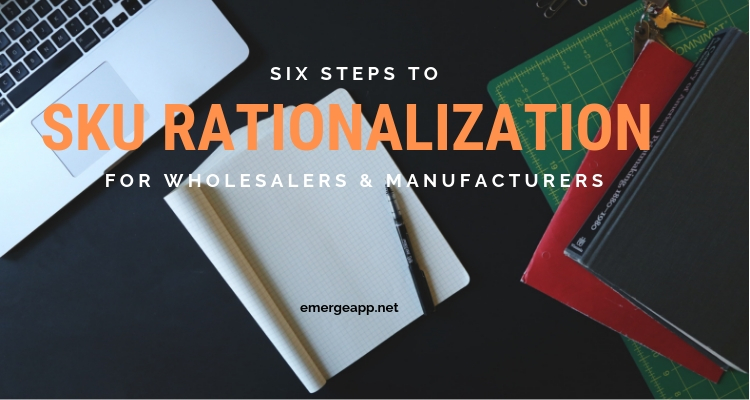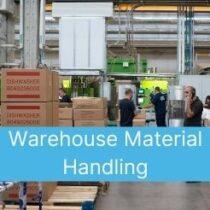6 Steps to SKU Rationalization for Wholesalers and Manufacturers

In the never-ending quest to satisfy retailers and consumers, it’s too easy to carry far too many products than you need. Consumers demand a greater variety in the depth and breadth of goods. Retailers want stock that is ready to ship now. And wholesalers and manufacturers dislike losing sales orders and future business.
This leads to SKU spiral where wholesalers and manufacturers deal with an ever-increasing number of SKUs in their inventory. How can this spiral be halted? What can you do to optimize your inventory? Here, we’ll explore what is meant by SKU rationalization and the measures you can take to reduce inventory bloat, cut your carrying costs, and ironically, prevent stockouts.
Quick Links
What is a SKU?
SKU stands for Stock Keeping Unit. It is a unique identifier for each product in your inventory. This allows products to be identified and tracked for inventory control purposes. There is no international standard for SKU codes but they are usually alphanumeric codes that are 6-8 characters long.
Like UPC and EAN barcodes, SKU codes can be printed as machine-readable barcodes. But unlike UPC/EAN barcodes there is no cost to a business to use SKU codes. They are internal codes used solely for inventory management purposes. The only cost, of course, is a barcode generating, printing and scanning system that works with your inventory management system.
Remember, SKUs are for internal use only. If you want to use barcodes for e-commerce platforms or trade with other businesses then you’ll need UPC/EAN codes. These are standardized and must be purchased from a barcode wholesaler.
What is SKU Rationalization?
SKU rationalization in its simplest form is a thorough spring cleaning of your stock of inventory. Like housekeeping, it should ideally be done every 6 months. Any shorter there will not be enough historical data to gauge product sales. Wait too long and there may not be enough time to effect changes to counter inventory bloat and any opportunity cost.
So, just like picking through your wardrobe and cupboard at home, you go through each SKU in your product catalog and decide whether to keep, toss or set aside. For those that you KIV, you probably want to revisit them in a second round to decide whether to truly keep or toss them.
SKU rationalization is typically used in the retail industry. Retailers have the most incentive to trim their SKU count every two seasons, summer/spring and autumn/winter. And they happen to coincide with a 6-month period. But inventory trimming need not be restricted to retail. Wholesalers, distributors, and manufacturers can use them too.
But then, how do you decide whether a particular product is a keeper? It’s not enough to rely on your intuition, a personal hunch, or a gut feel. There needs to be a consistent approach in sizing up products in your inventory. Next, we’ll cover a 6-step process to optimize your inventory.
How Do I Perform SKU Rationalization?
If there is only one paragraph that you read in this blog post, make sure it’s the next one. This is to emphasize the point that inventory optimization isn’t a one-off event. You need to do it periodically and fine-tune it as you go along. Smaller steps are preferred over large ones.
SKU rationalization should be seen as part of Product Life Cycle Management. It is a gradual, continuous process that takes place every 6 months. You should not trim your inventory according to whims and fancies, or without notice to your customers. You’re likely to alienate them with a bizarre product mix or one that is too constricted.
Use the following step-by-step process to optimize your inventory:
1. Revisit Your Marketing Strategy
Before diving into the nitty-gritty of SKUs, it’s worthwhile to revisit your marketing strategy. Not the bigger question of why are you in the business in the first place, but your marketing mix. This is typically described as the 4Ps: Product, Price, Place, and Promotion. Get your marketing mix right and you’ll sharpen your product mix and SKU count as a result.
This part will require a bit of brainstorming and soul searching. Your marketing mix is fundamental to your business’ value proposition in the market. Who are your target customers? What will you offer them. How much will you price your products for them? Where will you find your customers? How will you sell to them?
For example, let’s say that you’re a wholesaler of artificial plants and trees. Do you go high-end or low-end with your botanic offerings? This will inform you how you’re going to price your products. Also, where do your customers like to find your product? In a brick-and-mortar showroom, a warehouse store, or a B2B e-commerce platform?
2. Finetune Your Product Catalog
Revisiting your marketing strategy will take time and thought. It’s not to be rushed as it underpins your business value proposition. Once you have your marketing mix sorted out, take a good look at your products and ask yourself if they fit in the marketing plan. It should be obvious once you have at least Product, Price and Place sorted out.
Like spring cleaning, go through each product and put them into three columns: keep, toss, set aside. The ones that you set aside are trickier as you want to revisit them again when you’re much clearer in your marketing vision. They may not be easy to categorize at the first instance but may take some thought to place them.
Let’s say that you want to focus on the high-end as you’re tired of selling fake plants by the container load. So your products are likely to be those high-valued and high-priced items. Dump the single stem artificial flowers and focus on the large plants and tropical trees. Even fake Bermuda grass costs a pretty penny per square feet, so you decide to keep these.
3. Know Your Customers Well
Now that your products have been sorted out, it’s time to take a good look at your customers. If you’re using any sort of inventory management software, or even spreadsheets and paper records, you should have a good idea of the historical sales orders for each customer. Sort your customers by the total value of orders made in the past 6 or 12 months and look at the products they ordered.
This is where you need to do some simple CRM (Customer Relationship Management). For smaller businesses, it might simply be having a chat with them. For larger businesses, you may have to analyze your sales data and crunch numbers. You want to know how many customers account for your top sales. There may be a Pareto principle at work here where 20% of your customers account for 80% of your sales.
Sorting your customer records by sales value for the past 12 months revealed that your top customers were, in fact, landscape architects and design firms. They bought exotic trees and plants in bulk to furnish their showrooms, show flats, and show houses. It was far more eco-friendly than watering plants and trees every day. They only needed to be dusted.
4. Forecast Switching and Cannibalization
While you have your customer sales records at hand, it’ll also be good to take a look at any history of product switching and sales cannibalization. Product switching refers to customers switching their purchases between different brands. Sales cannibalization describes a drop in sales of existing products when a new one is introduced.
Looking at your sales records you see very little signs of product switching or sales cannibalization. Artificial plants tend to be commodity products with no brands to associate them with. Also, plants and trees tend to have their own discrete product groups so that an introduction of a new product tends to have no effect on sales of others.
However, you do see signs of a seasonal effect on fake plants and trees. The autumn/winter season sees purchases gradually shift to Christmas-like pine and fir trees, mistletoe and berries. Spring/summer pushes orders to bright floral plants, tropical fruit trees, and rainforest-type cover. Thankfully, your SKU rationalization takes place every 6 months so that you can account for seasonal factors.
5. Balance Carrying Costs versus Incremental Sales
If you remember, inventory carrying costs or holding costs are all those expenses associated with keeping inventory. They include fixed and variable costs such as warehouse rent, warehouse salaries, utilities, and insurance premiums. There’s also the non-quantifiable cost of purchasing other stock or using your money elsewhere, that is, opportunity cost.
You need to balance the costs of carrying inventory with any projected incremental sales. Ask yourself, if I carry this stock to sell, how much more will it contribute to my sales? And weigh up that additional contribution to the costs of carrying that stock. This will tell you whether it is feasible or cost-effective to keep the product or ditch it.
Calculating your inventory carrying costs revealed some useful information. On an annual basis, your holding costs are about 30% of your inventory’s value. This is a little on the high side of a typical 20-30% range for most businesses. Your high-value artificial plants are increasing insurance premiums slightly but you find that you are overstaffed.
In the past, you hired warehouse staff to move crates and container loads of small low-value plants and shrubs. Since you’re dealing with larger and more expensive fake trees now, you need less labor to move each individual tree. And a lot of the work can be mechanized with pallet jacks. You make the decision to assign your surplus warehouse staff elsewhere.
6. Review and Repeat SKU Rationalization
Once you have sorted out your SKUs into two piles to keep or drop, you should have a markedly different product catalog left. It should be sharper and more focused in line with your marketing objectives, and ultimately business objectives. You should have trimmed slower-moving or dead stock and replaced them with those that will bring incremental sales.
Let this new product catalog settle in for 6 months. Remember, you don’t want to upset your existing customers with wild product swings and mass removal of products that they have been accustomed to. Review your sales and SKUs again after 6 months. This should give you ample time to see a trend forming and make an informed decision about whether to optimize your SKUs further.
You review your sales 6 months after rationalizing your SKUs. As expected, you’re seeing fewer sales orders but each order is of a very large value. In the past, you saw many sales orders but each one was for lower-value items such as individual plants and stalks of flowers. Your SKUs have been trimmed by 20% but you’re tightly focused on your core artificial plants and trees that drive most of your sales now.
Conclusion
You’ve seen that SKU rationalization is a continuous task that is part of your overall Product Life Cycle Management. Product changes should be gradual so that trends in sales can be seen over time. Think of it as making little enhancements to your stockpile of inventory here and there. And remember that reviewing your SKUs is an ongoing process.













